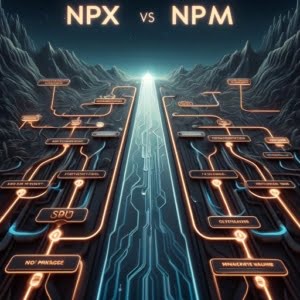NPX vs NPM | Key Differences and Usage Cases?

When managing Node.js projects at IOFLOOD, understanding the differences between NPX and NPM became necessary. By researching the usage cases of these tools, I’ve crafted this comparison guide to shed light on their unique functionalities. Whether you’re executing commands directly with NPX or managing dependencies with NPM, this guide aims to provide guidance for your development workflow.
This guide will illuminate the distinct roles of npx and npm, providing clarity on their functionalities and advising on the appropriate scenarios for their use. By the end of this exploration, you’ll not only grasp their differences but also appreciate the unique advantages each tool offers to your development workflow.
Let’s dive into the mysteries of npx and npm, and gain the knowledge to navigate JavaScript with confidence.
TL;DR: What’s the Difference Between NPX and NPM?
NPX is used for running packages without installing them, while NPM is primarily for managing and installing packages. You can use NPX for one-off commands such as,
npx create-react-app my-appand NPM for package management commands such as,npm install create-react-app -g.
Here’s a quick example to illustrate:
# Using npm to install a package globally
npm install -g create-react-app
create-react-app my-app
# Using npx to run a package directly
npx create-react-app my-app
# Output:
# Creates a React app named my-app without globally installing the create-react-app package.
In the first example, we use npm to globally install the create-react-app package and then use it to create a new React application. This method requires the package to be installed globally on your machine. In contrast, the second example demonstrates how npx allows you to execute the create-react-app command directly without the need for a global installation, making it a more convenient and cleaner approach for one-time package executions.
If you’re intrigued by the simplicity and efficiency of using npx over npm for certain tasks, keep reading. We’ll explore more about these tools, including advanced use cases and best practices.
Table of Contents
Getting Started with npm
NPM, at its core, is the world’s largest software registry. Open source developers from every continent use npm to share and borrow packages. Many organizations also use npm to manage private development. In essence, npm is a package manager for JavaScript that allows developers to install and manage library dependencies with ease.
Installing a Package with npm
Let’s dive into a simple example of installing a package using npm. For instance, if you wanted to install lodash, a popular JavaScript utility library, you would execute the following command:
npm install lodash
# Output:
# + [email protected]
# added 1 package in 2.45s
This command downloads lodash and adds it to your project’s node_modules directory, making it available for import in your JavaScript files. The output confirms the successful installation of the lodash version 4.17.21, showcasing npm’s role in managing dependencies efficiently.
Getting Started with npx
Following npm, npx stands as a remarkable tool in the JavaScript ecosystem. Introduced with npm version 5.2.0, npx is a package runner that simplifies the process of using Node.js packages. Its primary function is to execute any package you might need for a project directly from the command line without having to install it globally.
Running a Package with npx
To illustrate, let’s run a package using npx. Suppose you need to check the version of create-react-app available. Instead of installing the package globally, you can simply execute:
npx create-react-app --version
# Output:
# 4.0.3
This command momentarily installs create-react-app to relay its version and then disposes of it post-execution. It’s a prime example of npx’s capability to run packages temporarily, which is especially useful for one-off commands or scripts. This feature of npx not only saves space on your device but also keeps your global space clean from unnecessary package installations.
Advanced Usage with npm
npm is not just about installing packages. It’s a powerful tool that supports various aspects of project management, including script running and version control. Let’s explore how npm can be used to run scripts defined in your package.json file.
Running Scripts with npm
Consider you have a script named start defined in your package.json that starts your application. Running this script is as simple as executing the following command:
npm run start
# Output:
# > node app.js
# Server started on port 3000
This command triggers the execution of app.js, starting your server. npm’s ability to run scripts defined in package.json simplifies complex commands into manageable, memorable scripts, enhancing development workflows.
Advanced Usages of npx
npx shines in scenarios where you need to run a package without installing it globally. This capability is particularly useful for packages used intermittently or for trying out packages.
Executing Non-Global Packages with npx
Imagine you want to use the cowsay package, a fun utility that generates ASCII pictures of a cow with a message. Instead of installing cowsay globally, you can run it directly with npx:
npx cowsay 'Hello, npx vs npm!'
# Output:
# ________________
# < Hello, npx vs npm! >
# ----------------
# \ ^__^
# \ (oo)\_______
# (__)\ )\/\
# ||----w |
# || ||
This command temporarily installs cowsay, executes it with your message, and then removes it from your system. It’s a perfect illustration of npx’s power to execute one-off commands without cluttering your global namespace, demonstrating its efficiency and convenience for JavaScript developers.
Both npm and npx offer unique advantages for managing and executing packages. Understanding when and how to use these tools can significantly optimize your development process, making it smoother and more efficient.
Exploring Alternate Package Managers
While npm and npx play pivotal roles in JavaScript development, they are not the only tools in the ecosystem for package management and execution. Yarn, introduced by Facebook, emerged as a strong contender, offering features that cater to specific needs of developers.
Yarn: A Quick Overview
Yarn is a fast, reliable, and secure dependency management tool. It caches every package it downloads, so it never needs to download the same package again. It also parallelizes operations to maximize resource utilization so install times are faster than ever.
yarn add lodash
# Output:
# [1/4] Resolving packages...
# [2/4] Fetching packages...
# [3/4] Linking dependencies...
# [4/4] Building fresh packages...
# success Saved lockfile.
# success Saved 1 new dependency.
The output highlights Yarn’s efficiency in handling dependencies. By caching and parallelizing operations, Yarn ensures a swift and smooth package installation process, making it a favored choice for projects requiring speed and efficiency.
npm vs. npx vs. Yarn
While npm and npx are bundled together, offering a cohesive experience for managing and executing packages, Yarn provides a unique set of features that cater to different developer needs. For instance, Yarn’s lockfile feature ensures that the same package versions are installed across all environments, enhancing consistency and reliability in projects.
Moreover, Yarn’s workspaces feature facilitates managing multiple packages within a single repository, which is an advantage for monorepo setups. This capability, combined with its efficient dependency management, makes Yarn a compelling option for large-scale projects.
Making the Right Choice
Choosing between npm, npx, and Yarn depends on your project’s specific needs and your personal or team’s preferences. If you value the simplicity and directness of executing packages without installation, npx shines. For comprehensive package management and script execution, npm has stood the test of time. However, if your project benefits from fast installations and consistent environments across teams, Yarn might be the tool for you.
Understanding the strengths and limitations of each tool allows developers to make informed decisions, optimizing their workflows and ensuring the success of their projects in the dynamic JavaScript ecosystem.
Troubleshooting Issues: NPX and NPM
When working with npx and npm, developers may encounter a range of issues from version conflicts to slow execution times. Understanding how to address these challenges is crucial for maintaining a smooth development workflow.
Handling Version Conflicts
Version conflicts can arise when different parts of your project depend on incompatible versions of the same package. This is where npm’s package-lock.json or Yarn’s yarn.lock files become invaluable, as they lock the installed dependencies to specific versions.
To resolve version conflicts, consider using the npm ls command to list installed packages and identify conflicting versions:
npm ls lodash
# Output:
# [email protected]
# ├─┬ [email protected]
# │ └── [email protected] deduped
# └─┬ [email protected]
# └── [email protected]
This output shows that dependency2 is using an older version of lodash, which could lead to conflicts. Updating dependency2 or adjusting your project to use a compatible version of lodash can help resolve this issue.
Package Not Found Errors
Package not found errors usually occur when trying to run or install a package that doesn’t exist or has been misspelled. Double-checking the package name and version in the npm registry can quickly solve this problem. If using npx, ensure the package is available and correctly named.
Overcoming Slow Execution Times
Slow execution times with npm can often be attributed to network issues or the npm registry itself. Using a different network, or switching to a faster npm registry mirror, can improve installation times. For npx, slow execution might be due to the on-the-fly installation of packages. Pre-installing frequently used packages globally or using a package caching tool can mitigate this.
Understanding these common issues and how to tackle them enhances your efficiency in using npx and npm. By applying these solutions and best practices, developers can ensure a more productive and less frustrating experience in their JavaScript projects.
The Evolution of npm and npx
The JavaScript ecosystem has grown exponentially over the years, and with it, the need for effective package management solutions. npm, standing for Node Package Manager, emerged as a cornerstone of this ecosystem, providing a comprehensive registry of JavaScript packages and a command-line client for interacting with these packages. Since its introduction in 2010, npm has revolutionized the way developers share and consume JavaScript code, laying the foundation for a more connected and efficient development process.
npm: Powering JavaScript Development
npm made its debut as part of the Node.js environment, quickly becoming the default package manager for JavaScript. Its impact on the development community has been profound, simplifying the process of adding, updating, and removing external libraries or packages in projects.
npm init
# Output:
# This utility will walk you through creating a package.json file.
# It only covers the most common items, and tries to guess sensible defaults.
The npm init command, for example, streamlines the creation of a package.json file, a crucial component in any Node.js project. This file keeps track of all the dependencies your project needs, ensuring that anyone who works on the project can easily install these dependencies with a simple npm install command.
The Birth of npx: Enhancing npm’s Capabilities
With the release of npm 5.2.0 in July 2017, npx was introduced as part of the npm package. npx is a command-line utility that enhances npm’s capabilities by allowing developers to run packages without installing them globally. This innovation addressed a common frustration among developers: the clutter and version conflicts caused by globally installed packages.
npx echo 'Hello, World!'
# Output:
# Hello, World!
In this simple example, npx echo 'Hello, World!' demonstrates npx’s ability to execute a command without requiring a global installation, showcasing how npx has made it easier to use and test packages in isolation. This feature is particularly useful for ensuring that projects remain clean and that their dependencies are easily manageable.
The introduction of npx alongside npm has significantly advanced JavaScript development practices. Together, they provide a robust set of tools that streamline the management and execution of packages, reinforcing the Node.js and JavaScript communities’ growth and innovation. Understanding the origins and functionalities of npm and npx is essential for developers looking to navigate the JavaScript ecosystem effectively.
NPX and NPM in Large-Scale Projects
As JavaScript projects grow in complexity and scale, the role of package management and execution tools like npx and npm becomes increasingly critical. These tools not only simplify dependency management but also play a pivotal role in automating and streamlining the build and deployment processes in continuous integration/continuous deployment (CI/CD) pipelines.
CI/CD Pipelines: Automating with npm
In the context of CI/CD, npm can be leveraged to automate the installation of dependencies and the execution of scripts, ensuring that the build and deployment processes are both efficient and consistent. For example, a package.json script can be used to run tests automatically before a deployment:
npm run test
# Output:
# PASS ./test/example.test.js
This command runs the test script defined in package.json, which could include linting, unit tests, and integration tests. The output indicates a successful test run, a crucial step before deploying changes in a CI/CD pipeline.
Dependency Management in Microservices
In microservices architectures, managing dependencies can become challenging due to the distributed nature of the services. npm helps in defining clear and concise package.json files for each microservice, ensuring that dependencies are isolated and managed effectively. This isolation helps in reducing conflicts and ensuring that each microservice can be developed, tested, and deployed independently.
Containers: The Role of npx
Containers have become a staple in modern development for encapsulating and deploying applications. npx plays a significant role in containerized environments by allowing developers to execute package scripts without the need for global installations, keeping container images lean and focused on the application itself.
npx sequelize db:migrate
# Output:
# Sequelize CLI [Node: 12.13.0, CLI: 5.5.1, ORM: 5.21.3]
# Migrations up to date
In this example, npx is used to run a Sequelize database migration directly, showcasing how npx facilitates on-demand script execution without bloating container images with unnecessary global packages.
Further Resources for Exploring NPX and NPM
To deepen your understanding of npx and npm and how they can be leveraged in large-scale projects, consider exploring the following resources:
- The npm Blog: Offers insights and updates directly from the npm team, covering best practices, new features, and more.
Node.js Guides: Provides a collection of guides for Node.js users, including topics on package management and deployment strategies.
The New Stack: Features articles on modern development practices, including the use of containers, microservices, and DevOps methodologies.
These resources offer valuable information for developers looking to enhance their use of npx and npm in complex and large-scale projects, ensuring efficient development and deployment processes.
Recap: Comparing NPX and NPM
In this comprehensive guide, we’ve delved into the intricacies of npx and npm, two cornerstone tools in the JavaScript ecosystem. We’ve uncovered their unique roles—npm as the go-to package manager that helps in installing and managing your project’s dependencies, and npx as the package runner that allows for executing Node.js binaries and other executables directly, without global installation.
We began with the basics, illustrating how npm simplifies the process of managing project dependencies. We then explored npx, highlighting its ability to run packages directly, which is particularly useful for one-off commands or when trying out new tools without cluttering your global namespace.
Moving to more advanced uses, we examined npm’s capabilities beyond package installation, such as script running and version management. We also delved into npx’s power to execute non-global packages, showcasing its utility in modern development workflows.
In comparing alternatives like Yarn, we provided insights into the broader landscape of JavaScript package management and execution tools, giving you the knowledge to choose the right tool for your needs.
| Tool | Primary Use | Installation Requirement |
|---|---|---|
| npm | Package management | Global and local |
| npx | Package execution | No global installation required |
| Yarn | Package management and execution | Global and local (with focus on speed and consistency) |
Whether you’re just starting out with JavaScript development or looking to refine your workflow, understanding the nuances between npx and npm is crucial. Each tool has its strengths and use cases, and knowing when to use one over the other can significantly enhance your productivity and project management.
With the knowledge gained from this guide, we encourage you to experiment with both npx and npm in your projects. Exploring their functionalities firsthand will not only solidify your understanding but also empower you to make informed decisions in your development process. Happy coding!


